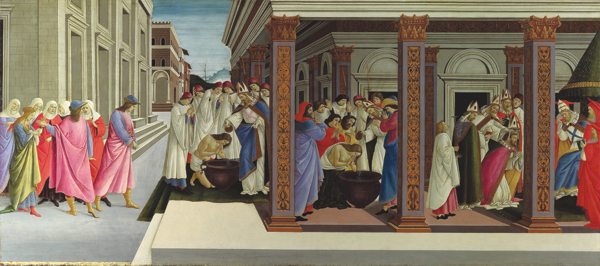Renaissance ethos – contemporary views
Botticelli / Frankfurt, Staedel, 13. 11. 2009. ŌĆō 28. 02. 2010.
Botticelli to┬ĀTizian / Budapest,┬ĀMuseum of Fine Arts, 28. 10.┬Ā2009.┬Ā ŌĆō 14. 02. 2010.

Botticelli: Saint Zenobius
The large-scale exhibition entitled Botticelli to Titian. Masterpieces of Two Centuries of Italian Painting will display paintings on loan to the Museum of Fine Arts from over fifty museums, including the Uffizi in Florence, the Louvre in Paris, the national galleries of London and Washington, the Metropolitan Museum in New York, the Galleria Borghese in Rome and the Prado in Madrid. In addition to works by Botticelli and Titian, the 130 paintings on show represent the art of over eighty masters, among whom are Leonardo, Giorgione, Raphael, Veronese and Tintoretto.
The exhibit of 15th-16th-century Italian painting offers visitors the opportunity to familiarise themselves with masterpieces by the greatest artists of the period and explore the emergence and development of intellectual and artistic processes in the most important cultural centres. For the very first time in Hungary the Italian Renaissance will be presented in a spectacular, large-scale exhibition with a sound scholarly foundation. The works on loan will be supplemented by thirty-five paintings from the Museum of Fine ArtsŌĆÖ own prestigious Italian collection.

- Botticelli: Minerva and Kentaur
Sandro BotticelliŌĆÖs painting has become a landmark of Italian Renaissance, and his monumental Idealized Portrait of a Lady (c. 1480) numbers among the St├żdel MuseumŌĆÖs main works. The ideal beauty of his mythological figures and the elegant grace of his Virgin figures make his creations the epitome of Florentine painting in the Golden Age under Lorenzo the MagnificentŌĆÖs rule. It is less his masterful translation of Renaissance ideals which is the reason for the much-praised magic of his pictorial solutions, but rather the exceptional expressiveness of his figurative creations presenting their classically refined beauty in a solemn manner and with an often melancholy note.
With a selection of portraits, mythological allegories and depictions of the Virgin ŌĆō altogether some eighty works by Botticelli, his workshop and his contemporaries ŌĆō the St├żdel Museum presenting the first exhibition ever to be devoted to the oeuvre of this great Italian Renaissance master in German-speaking lands.
Sandro BotticelliŌĆÖs painting has become a landmark of Italian Renaissance, and his monumental Idealized Portrait of a Lady (c. 1480) numbers among the St├żdel MuseumŌĆÖs main works. The ideal beauty of his mythological figures and the elegant grace of his Virgin figures make his creations the epitome of Florentine painting in the Golden Age under Lorenzo the MagnificentŌĆÖs rule. It is less his masterful translation of Renaissance ideals which is the reason for the much-praised magic of his pictorial solutions, but rather the exceptional expressiveness of his figurative creations presenting their classically refined beauty in a solemn manner and with an often melancholy note.

- Bellini: Annunciation
